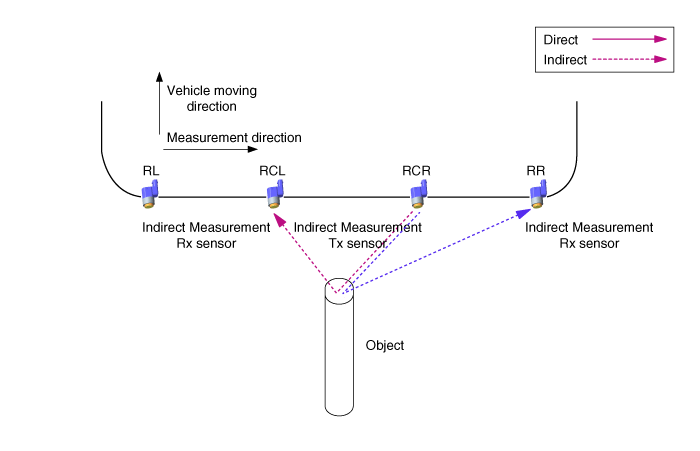Hyundai Genesis: Front / Rear Parking Assist System / Description and Operation
Hyundai Genesis (DH) 2013-2016 Service Manual / Body Electrical System / Front / Rear Parking Assist System / Description and Operation
| System Overview |
RPAS (Rear Parking Assist System) is an electronic driving
aid that warns the driver to be cautious while parking or driving at low
speed. The sensor uses ultrasonic waves to detect objects within
proximity of the vehicle.
RPAS consists of four RPS sensors which are detecting the
obstacles and transmit the result separated into three warning levels,
the first, second and third to BCM by Lin communication. BCM decides the
alarm level by the transmitted communication message from the slave
sensors, and then operates the buzzer or transmits the data for display.

System Block Diagram

System Operation Specification.
| 1. |
INIT mode
|
| 2. |
NORMAL Mode
|
| 3. |
TUNNING MODE
|
| 4. |
CONFIGURATION MODE
|
Sensing Area
| 1. |
Measurement condition – PVC pole (diameter 75mm, length 1m), normal temperature |
| 2. |
Distance range detected objects (Measured directly in front of sensor)
61cm(24.0in) ~ 120cm(47.2in) : ± 15cm(5.9in)
31cm(12.2in) ~ 60cm(23.6in): ± 15cm(5.9in)
Less than 30cm(11.8in) : ± 10cm(3.9in) |
Horizontal Sensing Area

Vertical Sensing Area

Distance Measurement
| Direct Measurement |
Transmission and Reception are executed with one sensor
(RL, RCL, RCR, RR each sensor execution)

| Indirect Measurement |
(RCL > RL, RCL > RCR, RCR > RCL, RCR > RR Execution in order)
With two or three sensors, one of them sends the transmission and the others get the reception.

| Direct and Indirect Measurement at once |
With two or three sensors, the one sensor performs both transmission and reception, and the others perform only reception.

RPAS alarm system
When the RPAS sensor detects the object, warning is operated
by audible alarm device as like buzzer. RPAS sensor sends data to BCM
via LIN communication and BCM implements audible warning for each RPAS
SENSOR by priority. And it performs a role of gateway only when it sends
visible alarm device such as Cluster.
| - |
Sensor buzzer/display information processing method of BCM In
case of RL/RR sensor information, the BCM handles each sensor
information directly about Display and buzzer output function. Buzzer
output of CL/CR sensor, BCM handles center combination information by
priority both sensor. |
System Operation Spec
When the system has the power (after IGN ON and R gear),
MICOM checks every sensor channel. In case it finds any error, it gives
off the buzzer for 300ms after 500ms.
If an error is found even in a sensor, it gives off the
buzzer corresponding to the faulty sensor, instead of initial starting
alarm. The operation to enter the normal mode is as follows.

With the R gear put in the car, the system is operated as follows.

With the R gear released, the system is operated as follows.

? The acceptable error range on waveform is ±10%.
Alarm Output Specification classified by distance between sensors
Condition logic according to priority of alarm level is as below. (the identical sensor)

*? value definition
| 1. |
low priority sensor off : ? = 0ms |
| 2. |
low priority sensor is 1st warning level : ? < 340ms |
| 3. |
low priority sensor is 2nd warning level : ? < 170ms |
*? value definition
| 1. |
low priority sensor is 1st warning level : ? = 1700ms |
| 2. |
low priority sensor is 2nd warning level : ? = 1700ms |
| 3. |
low priority sensor is 3rd warning level : ? = 700ms |
Alarm control by sensing distance is as follows.
| 1. |
First warning area (61cm ~ 120cm)
|
| 2. |
Second warning area (31cm ~ 80cm)
|
| 3. |
Third warning area (less than 30cm)
|
Visible Alarm Indicator Specification
When the gear shifts to R, the cluster controls the indicator as the following picture.
When the system detects an object, it immediately turns on
the indicator. If an object disappears while the RPAS detecting
operation, the indicator remains on for 2 sec. before being turned off.
(The third alarm>

| - |
It shows only the detecting position of obstacles. |
| - |
In third level alarm, indicator flickers at intervals of a second. |
| - |
In normal alarm mode, integrated display of RCR/RCL |
Communication Standard
This section defines the communication between RPAS and BCM.
RPAS send a detecting result of object and sensor diagnosis
result to BCM according to this document, and BCM takes a role to issue
an alarm.
Indicator shows the transmitted position and alarm data, in
the alarm mode, it finds the nearest DATA and alarms the nearest DATA
first.
(Ex. In case, RL isthe first-step alarm and RR is the third step, RR alarm has priority.)
 Components and Components Location
Components and Components Location
Component Location
1. BCM (Body Control Module)2. Ultrasonic sensor
Rear parking assist control unit function is built in BCM (body control unit). ...
 Parking Assist Sensor Components and Components Location
Parking Assist Sensor Components and Components Location
Component
...
Other information:
Hyundai Genesis (DH) 2013-2016 Service Manual: Airbag Module Disposal Description and Operation
Airbag Disposal Special tool required Deployment tool 0957A-34100A Before scrapping any airbags or side airbags (including those in a whole vehicle to be scrapped), the airbags or side airbags must be deployed. If the vehicle is still within the warranty period, before deploying the ai ...
Hyundai Genesis (DH) 2013-2016 Owners Manual: Emission control system
The emission control system of your vehicle is covered by a written limited warranty. Please see the warranty information contained in the Owner’s Handbook & Warranty Information booklet in your vehicle. Your vehicle is equipped with an emission control system to meet all applic ...
© 2013-2025 www.hgenesisdh.com



